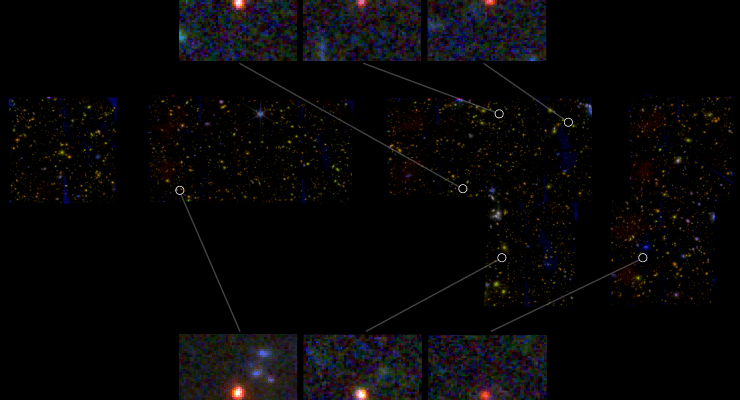
The discovery of (potentially) six galaxies that contain more gas than was thought to exist in the entire universe put together was nothing short of a “spitting out my coffee moment” for lead researcher Professor Ivo Labbé.
“We were looking at the kindergarten of a universe,” Labbé told Crikey. “At kinder you expect to see toddlers. The average toddler weighs eight to 10 kilograms. What did we find? Toddlers that weigh 100kg but they’re only five centimetres tall.”
“Very, very strange.”
His team at Swinburne University of Technology used the James Webb Space Telescope to launch a search party to look back to approximately 600 million years after the big bang. When Labbé sighted the monstrosity that was in the order of 100 billion times the mass of the sun, “a lot of four-letter words” were dropped.
“When you’re looking at lots of images through telescopes, you start to get a feel of what you might see,” he said. “But when I saw this, I thought, ‘Uh oh this shouldn’t be there’.”
Labbé immediately called a red alert and summoned all hands on deck to try to find more of these gigantic — yet utterly compressed — baby editions of galaxies. And he did.
In a record two to three days, his team had whipped up a report paper (a process that usually takes months) and caused quite the stir in the scientific community. After four months of “proving to our critics why our methods were valid”, the findings were published today in Nature.
So what exactly is so “big” and out of sorts about a galaxy “more massive than your average adult but also 30 times smaller”? In short, it runs headlong into all manner of theoretical limits.
Scientists have the tools to calculate the amount of gas in the universe at a given point in time. The problem, Labbé said, was that the amount of gas believed to have existed at 600 million years ABB (a non-scientific acronym coined by Crikey that stands for “after big bang”) was the amount of gas required to produce just a few of these monster galaxies.
“If the entire universe of gas is used to create these, then that’s not enough gas,” he said, running the numbers for Crikey.
Current cosmological theory is based on the premise that galaxies start small and grow big as they age. Also, like humans, they are creatures of waste, using only 5% to 10% of the gas given to them at conception for the designated purpose of making stars.
“You basically need 100 buckets of gas to build five buckets of stars,” Labbé said. Everything else goes to waste.
There is nothing in space handbooks to account for a galactic fast-track channel that not only gives birth to big babies, but does so with 100% gas-to-star efficiency. We’re talking zero waste.
The six potential (officially called “candidate”) galaxies require further investigation and verification before they’re eligible to reconfigure the rules for the making of a universe. Currently, the astronomical revelations are based on a few red dots — mere “smudges of light” that offer “limited detail”.
To ensure the images are what they claim to be, Labbé said his team would roll in the spectrograph. This splits the pinpricks of light and will allow the researchers to see what it’s made of and where it’s coming from.
Labbé gives it six to 12 months to properly test whether these massive systems are breaking theory, but he’s confident he’s at the forefront of a “once-in-a-generation” scientific revolution: “The universe is a lot weirder than the human imagination. You couldn’t make these things up.”








I remember a line from somewhere-
“The universe is not only stranger than we imagine, it is stranger than we can imagine.”
But is anything weirder than the Liberal Party?…………………
Yes, the Young Liberals. 😉
I assumed they inhabited a different universe………………
……….probably just wishful thinking.
We’re in a sweet spot of human history to see and study these marvels. Especially in regards to them actually being visible and not permanently beyond the boundary of light speed. I really hope humans can turn it around and see how lucky we truly are to even exist before we become a brief footnote in the universe’s bibliography.
600 my after the Big Bang? We do not really know if it happened that way. There are very significant holes in the theory. We also have no idea if light that has travelled for 10 billion years might have been influenced. We also do not “know” that the Cepheid variable stars that we base our distance calculations (they are not measurements as such) are as consistent as we believe, we have only a centuries worth of knowledge. Nor do we know for sure that type 1a supernovae are the clones that we assume. We think we do. Cosmology is in some ways like a religion, it makes some claims that cannot be tested without relying on other claims that are also hard to truly test. It is certainly interesting and may set off a lot of changes. we shall see.
And man made God in his own image.
That is science. Theories change as more evidence comes to light or more successful experiments are undertaken. Recent steps forward in technology have seen many of these theories change or be updated – JWST is the best example of that. Thankfully the science community aren’t afraid to admit when they’re wrong and, like most intelligent humans, use it as a chance to learn and progress their discipline. Science is about making observations on the world we live in and then trying to prove those observations through measurements and experiments. For example, Einstein’s theory that mass causes space to curve, i.e. the theory of general relativity, was proven four years later by observations during a solar eclipse. Those observations would not have been possible without the appropriate advancements in technology. As with JSWT these advancements continue to shine new light on we actually KNOW about the universe.
Apart from having overzealous supporters, how is that at all like religion?
If anything, the very opposite of religion……………
…………where “Faith” trumps Fact, and “Revealed Truth” is immutable.
Try explaining the Big Bang to the Taliban…………….
(Or for that matter, Morrison)
Cosmology is nothing like a religion. Pretty much all of science is based on coming up with explanations which can fit all of the observations we have so far. It stands to reason that when new observations are made, the explanation might need to change…. some simple assumption is replaced by something more complex for example. Religion on the other hand cares nothing for observation, or logic. When an observation is made, it is dismissed by the authoritarian cabal of men in charge of the religion with a simple ‘god made it that way’. Honestly, if you really are old and greybearded you should have been able to nut this out decades ago.
Surely Scomo is in charge of concentrated gas deposits like these in his galactic fast-track channel ministry. Check the Engadine area for galactic coronal ejections.
I think you’ll find that Galactic coronal ejections are only legal between consenting adults……………………….
Because that is how little galaxies are born…
Missing 98% of mass, too little gas, contracting expansion and expanding contraction, black holes, quasars and starwhales – beats LGM.